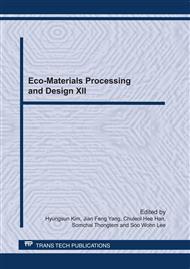p.81
p.85
p.89
p.93
p.97
p.101
p.105
p.109
p.113
Application of Acid Modified CuO/Al2O3 Nanostructured Catalysts and its Cytotoxicity Assessment for Enhanced CH4-SCR Performance
Abstract:
The effect of treatment with different inorganic acids (HNO3, CH3COOH, and H3PO4) on the activity of CuO/γ-Al2O3 nanostructured catalysts selective catalytic reduction of NO by hydrocarbons (HC-SCR) using CH4 as a reducing agent in a tubular fixed-bed reactor (TFBR) at temperatures from 623-1023 K in the presence of oxygen was studied. A CuO/γ-Al2O3 nanostructured catalyst was prepared by incipient wetness impregnation approach of copper nitrate and γ-alumina support. The catalysts were characterized using AEM and XRD. The experimental results show that the support γ-alumina with a 6 N HNO3 solution at the calcinations temperature of 873 K obvious promoting effects on the higher activity due to greater acidity of the transforming NO reaction over a CuO/γ-Al2O3 nanostructured catalyst, because the acidic pretreatment provides the acidic sites for the catalyst surface and improved the dispersion of copper species and the reactivity over the catalyst reaction system with NO-CH4-O2. Further, cell cytotoxicity and the percentage cell survival was determined by using MTS assay on human fetal lung tissue cell (MRC-5). The experimental results show that the nanoscale CuO/γ-Al2O3 catalyst only minor cause cytotoxicity effect in cultured human cells.
Info:
Periodical:
Pages:
97-100
Citation:
Online since:
July 2011
Authors:
Price:
Сopyright:
© 2011 Trans Tech Publications Ltd. All Rights Reserved
Share:
Citation:


